Wild Adventures
Los Llanos, western Venezuela
by Sarah Shuckburgh
The vast number of animals and birds drawn to the plains of Los Llanos, in Venezuela, are just one more reason to visit, as Sarah Shuckburgh discovers.
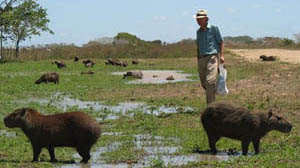 Who would guess that the highlight of our trip to
Venezuela would be three days staying in a spartan cabin on
a dead-flat 100,000-acre cattle ranch? The plains of Los
Llanos cover a third of the country, from the Andes to the
Orinoco. The climate is uncomfortably extreme – torrential
rain and floods, followed by searing heat, wind and drought
– but we have, by chance, arrived after the rains, and
before the worst of the heat. This is the best time to
visit, when the plentiful wildlife congregates at dwindling
waterholes. I feel I have stepped into a childhood I-Spy
book in which each illustration contains a fascinating but
improbable assortment of animals and birds. Who would guess that the highlight of our trip to
Venezuela would be three days staying in a spartan cabin on
a dead-flat 100,000-acre cattle ranch? The plains of Los
Llanos cover a third of the country, from the Andes to the
Orinoco. The climate is uncomfortably extreme – torrential
rain and floods, followed by searing heat, wind and drought
– but we have, by chance, arrived after the rains, and
before the worst of the heat. This is the best time to
visit, when the plentiful wildlife congregates at dwindling
waterholes. I feel I have stepped into a childhood I-Spy
book in which each illustration contains a fascinating but
improbable assortment of animals and birds.
We arrive late at night, bumping through pot-holes, and
halting every few minutes to wake capybaras blocking our
route. Hefty-headed rodents the size of large dogs, the
capybaras are reluctant to budge, but eventually trudge
grumpily to the verge, followed by gaggles of adorable
babies.
We wake next morning to croaks from a small tree-frog in the
bathroom, and to a cacophony of birdsong – the nasal
knock-knock of buff-necked ibis, the honks of Orinoco geese
in the treetops, the low grumble of cormorants, the loud
cries of thornbirds and kiskadee flycatchers, the tweets of
wrens and a raucous chorus of caws, chatters, chirrups,
coughs and coos. A hummingbird flutters at the window
screen. This is one of the world’s best places for
bird-watching - at breakfast we meet three Norwegians who
have spotted 220 species in two days. The temperature in the
shade of the palm trees is perfect. A cloud of yellow
butterflies swoops across a hazy blue sky. Half a dozen
bright green iguanas stalk past on scaly dinosaur legs, and
plod methodically up trees. Beyond the picket fence, cowboys
herd white, hump-backed cows – riders and cattle forming
pale silhouettes in a halo of dust.
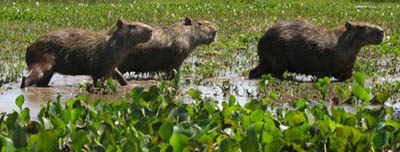 By 9am, the sky has darkened to a deep turquoise, fading to
the horizon where it meets the flat, grey-blue savannah. It
is getting hotter. We meet our wildlife guide, Jack, whose
first words are: “Don’t go out of the gate. That’s where the
crocs have laid their eggs”. Our driver, Musiú, is a local,
who gained his French nickname as a tall, pale-skinned
child. Musiú promises to find us an anaconda. By 9am, the sky has darkened to a deep turquoise, fading to
the horizon where it meets the flat, grey-blue savannah. It
is getting hotter. We meet our wildlife guide, Jack, whose
first words are: “Don’t go out of the gate. That’s where the
crocs have laid their eggs”. Our driver, Musiú, is a local,
who gained his French nickname as a tall, pale-skinned
child. Musiú promises to find us an anaconda.
We clamber aboard a huge canopied truck, and bump slowly
across bleached grasslands and past sunlit lagoons on our
first wildlife drive.
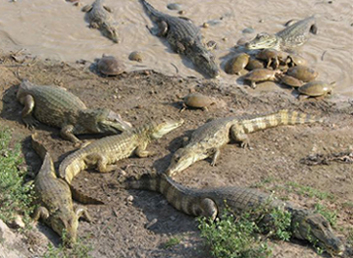 Clouds of dust billow behind us. All
around, capybaras loll in the sunshine, with eyes closed. We
pass a young researcher, sitting in a jeep. “She is studying
the social behaviour of capybara but she is very bored”,
says Jack. “Capybara do nothing all day”. Clouds of dust billow behind us. All
around, capybaras loll in the sunshine, with eyes closed. We
pass a young researcher, sitting in a jeep. “She is studying
the social behaviour of capybara but she is very bored”,
says Jack. “Capybara do nothing all day”.
We stop at an unremarkable sandbank by a shallow river. It
is a peaceful scene, with the usual hordes of dozing
capybaras. In the muddy water, the comical heads of
fresh-water terrapins bob beside the snouts of basking
caimans. Jack, a Venezuelan Crocodile Dundee, jumps down
from the truck on to the sand. Immediately, the muddy waters
heave and two gigantic Orinoco crocodiles, each 14 feet
long, pound towards us at 30 miles per hour, eyes glinting.
It is thrilling and terrifying. Jack leaps nimbly back on
board and the crocodiles suddenly freeze. Beneath the sand,
their eggs are incubating. Woe betide anyone who comes
close.
 Driving on, we see a 9-banded armadillo, which Jack catches
and allows us to hold. Despite its tough, rubbery armour,
its ears and belly are soft and fluffy. Later, we peer at
the strawberry-blond rump of a giant anteater, asleep on a
branch. It hears us, and lifts its head drowsily, flicking a
long, thin tongue. Huge, straggly wrens’ nests dangle
untidily from branches. Termites’ nests jut from tree
trunks. In a hollow log, we see a barn owl with four
round-eyed babies. Later we shine a torch on two raccoons
inside a tree stump. Driving on, we see a 9-banded armadillo, which Jack catches
and allows us to hold. Despite its tough, rubbery armour,
its ears and belly are soft and fluffy. Later, we peer at
the strawberry-blond rump of a giant anteater, asleep on a
branch. It hears us, and lifts its head drowsily, flicking a
long, thin tongue. Huge, straggly wrens’ nests dangle
untidily from branches. Termites’ nests jut from tree
trunks. In a hollow log, we see a barn owl with four
round-eyed babies. Later we shine a torch on two raccoons
inside a tree stump.
Musiú stops the truck by a hole in the sandy track – it’s an
iguana nest, shared by three or four females. A pile of
broken eggshells are evidence of a visit from a jaguar or a
caracara. The middle of the road is surprisingly popular for
nests - we see two burrowing owls sitting in their
underground lair, and later a turtle, squirting caked mud
and digging with clumsy flippers.
By noon it’s hot, and we return to the camp for lunch and a
siesta, lulled to sleep by shrill crickets. At 4pm Musiú
steers us across the wetlands in a flat-bottomed boat,
forging watery trails through floating carpets of mauve
water-hyacinths. Everywhere, wildlife forms spectacular
tableaux. In the shade of a stunted tree, capybaras stand,
suckling their babies, and spiky iguanas strike elegant
poses, next to less exotic white-tailed deer. Spectacled
caimans lurk in the water, with only bulging eyes and broad
snouts showing. Terrapins, basking on the bank, plop into
the opaque water as we approach, and bob like brown
ping-pong balls.
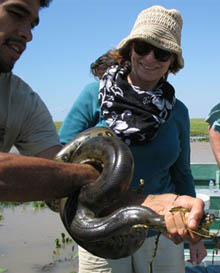 The sky is full of birds, and Jack teaches me to recognise
the most colourful and exotic. The roseated spoonbill is the
dusty pink of nylon knickers. Ibis come in startling hues –
scarlet, metallic black, blue and green. Flocks of jacana
flash bright yellow in flight, turning jet black with wings
folded. With long toes, they can stalk across floating
water-hyacinths. The lanky jabiru waders stand 4’6” tall. A
snake-necked anhinga stands at the water’s edge. Vermillion
and yellow-fronted flycatchers dart from branches to gobble
flies. Black collared hawks and Amazon kingfishers hover
with fluttering wings, and nosedive for fish. Opportunistic
caracaras chase other birds away and scavenge caiman eggs.
Small black vultures sit hunched on branches. And a hoatzin
clambers through the tangled vegetation, like a miniature
dinosaur. The sky is full of birds, and Jack teaches me to recognise
the most colourful and exotic. The roseated spoonbill is the
dusty pink of nylon knickers. Ibis come in startling hues –
scarlet, metallic black, blue and green. Flocks of jacana
flash bright yellow in flight, turning jet black with wings
folded. With long toes, they can stalk across floating
water-hyacinths. The lanky jabiru waders stand 4’6” tall. A
snake-necked anhinga stands at the water’s edge. Vermillion
and yellow-fronted flycatchers dart from branches to gobble
flies. Black collared hawks and Amazon kingfishers hover
with fluttering wings, and nosedive for fish. Opportunistic
caracaras chase other birds away and scavenge caiman eggs.
Small black vultures sit hunched on branches. And a hoatzin
clambers through the tangled vegetation, like a miniature
dinosaur.
Musiú watches the birds intently, and can tell when an
anaconda is lurking beneath the water. Suddenly he points at
a bed of hyacinths, and daredevil Jack wades in, returning,
minutes later, with a writhing anaconda, 10 feet long, and
as thick as his leg. We take turns to hold its tail and feel
the muscles of its scaly body, which coils and clenches
thrillingly. Musiú is not impressed – sometimes anacondas
are 36 feet long, he says.
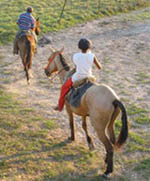 Back in the truck, we pass a tiny, barefoot boy on a mule.
Behind him, in a cloud of dust, looms a straggly herd of
floppy-eared cows - a hardy mix of Brahmin and Brazilian,
bred to survive the extreme climate. Their ribs show beneath
folds of loose skin. Three wizened cowboys follow, with
lassos looped from their saddles. Jack hands out iced water.
Later we pick up the empty bottles, arranged neatly by a
gate. Back in the truck, we pass a tiny, barefoot boy on a mule.
Behind him, in a cloud of dust, looms a straggly herd of
floppy-eared cows - a hardy mix of Brahmin and Brazilian,
bred to survive the extreme climate. Their ribs show beneath
folds of loose skin. Three wizened cowboys follow, with
lassos looped from their saddles. Jack hands out iced water.
Later we pick up the empty bottles, arranged neatly by a
gate.
El Cedral ranch was founded 100 years ago by a Rockerfeller.
Today the ranch is owned by Venezuelan businessmen, but is
divided into dozens of ‘fundos’, small ranches run by
llaneros. We pass a llanero homestead – a bleak, isolated
shack built on a small bank just above the flood level, with
a scrubby patch of manioc and banana plants. Tousled
children sit at the door – they have never been to school. A
wind turbine raises water to a tank, but there is no
electricity.
At dusk, we arrive at a lake surrounded by tropical forest.
For several minutes we listen to the night jars, and watch
flocks of birds settling in the trees. An opossum sneaks by,
its long tail pointed and stiff. Then suddenly a freshwater
dolphin leaps gracefully from the inky water. Further out,
another appears, splashing and spouting water; then two
together, elegant pinkish bodies arching out of the lake in
a synchronised dance. We watch them, spellbound, as darkness
falls.
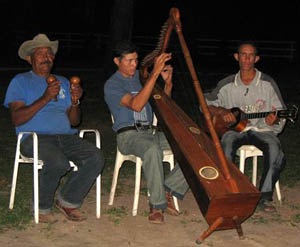
Los Llanos is the home of joropo music. Every village has a
band, and the ranch is no exception. After supper, a local
trio start to play – a young gardener plucks a small but
manly harp, a grizzled llanero strums a cuatro – a 4-string
guitar – and Musiú’s old father jiggles maracas, making a
sound like crickets. Another llanero sings. The music is
fast, wild and hypnotic, with complicated syncopated
rhythms. The melodies on the harp ring out, clear,
passionate and poignant. At intervals, power-cuts plunge us
into darkness, but the musicians play on by the light of the
moon and a thousand stars.
Sarah travelled with Sunvil Latin America,
www.sunvil.co.uk
First published by the Telegraph
©SarahShuckburgh |